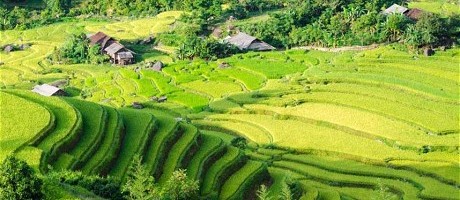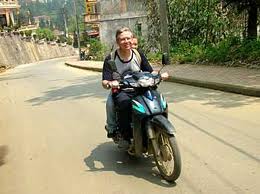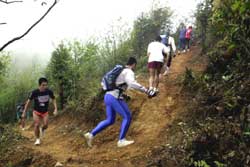Posted in Blog |

After a rude awakening, Anna settles in to daily rituals and spirited encounters with the people of Ha Giang It was 3.30am when the cockerel first crowed, an alarm all the more bone-jangling because it was right underneath the hut on stilts in which we were sleeping. Every 10 minutes or so that darn cockadoodle-do split the silence, until around the time when one actually might want to be woken up, at which point it went quiet. Vietnamese village life is not without its challenges for the unsuspecting tourist. (Home-brewed rice wine the colour of pond water, anyone? More on that later.) But they are nothing alongside its many delights. We were in rural Ha Giang, a mountainous northern region of Vietnam, close to the border with China. Ha Giang is a six-hour drive from Hanoi, and a world away, a place where currently very few tourists visit. Driving ever upwards into the mountains, we passed through a narrow gorge between two giant cliffs, the aptly named Heaven’s Gate. Beyond was a landscape of toothsome crags and wild forest and jungle, offset with the gentle, shimmering emerald of paddy fields. The mountains of Vietnam’s north, along with those of its interior, are where the majority of the country’s 53 minority groups live (the 13.8 per cent of the population who are not ethnic Viet), many of them upholding a way of life that has remained largely unchanged for centuries. Our first night in the region was spent at a pretty French-owned guesthouse in the village of Panhou, its rice paddy surrounds reinvented as an exotically planted water garden. No middle-of-the-night cockerel crows here; just some fairly low-key frogs. In the morning we went to the nearby market in the district of Thong Nguen, where we saw women from two different tribes meeting to shop and, more importantly, to gossip The Red Dao women wore a navy hemp outfit with a red trim. Their heads were haloed with a big coil of red trim, and on their chests was a large pewter necklace that looked more like the breastplate on a suit of armor. The Black Dao wore a black hemp outfit trimmed in white, and on their head was a black kerchief decorated with white cords. Whichever their tribe, the men wore modern clothes. Our guide Quang told us that women, especially unmarried ones, had less sartorial freedom because their reputation as a “good girl” would be at risk if they chose to abandon the traditional dress. The youngest had abandoned one practice however – the chewing of betel leaves. The older women were all betel chewers, their blackened teeth considered by them and their peers to be beautiful. Such is the comparative rarity of tourists in Ha Giang that we were as much an object of fascination to them as they were to us, a fact that lessened...
Read More »
Posted in Blog, Useful information |

The thing to do is rent a scooter and go on your own. There are more than enough places offering you bike rentals in Sapa town proper. If you are good with motorbikes, you can do 30km each hour with good breaks to enjoy the view and stop at local shops and food places; top speed is 50kmph average going up and down the hills. You can do a bit better if you are alone but do this only if you are used to driving on winding hills and bumpy roads. Pay 10 dollars for a full day rental… you can get it for 6-8 as well. You don’t need a driver’s license here… passport is good and no one checks as far as you pay the entrance fees. If you are not confident of driving here (there are no rules apart from being the hills), fill up petrol from the gas stations as and when you require. But, if you can drive, you will get a better deal with a full tank… they will fill it up for the equivalent for 3 liters since they expect travelers to drive more than that ;-D Expect 30km or so per litre so work it out for yourself. The town is a nice start if you need a bit of time to get used to your bike. Enjoy roaming around places that are not already crowded with the usual group of backpackers and Hmong women. If you fancy it, you can make it to the entry point of Cat Cat Village. Bikes aren’t allowed in. Head off to Tran Tom pass which has amazing views of the mountains and beyond. The roads are even better to ride around after the pass as it gets progressively more into the hills and the forests. Come back to Sapa and make it to rice paddy terraces and then down to the valley floor of Ta Phin which inverts the views you just had… from the bottom instead of the top. Better yet, instead of hopping on to a tour, take your motorbike to one of those remote Hmong markets in Bac Ha or Coc Ly and spend a few days out there. NOTE: Be respectful of the tribes. If you are part of a tour, they will take you to a lot of huts. Unlike the local guides, they don’t get a penny from your tours. They are just polite and don’t mind if you enter their premises but they do lead difficult lives. If you do enter their homes for travel purposes and showing pictures back home, do give them a bit in...
Read More »
Posted in Blog |

From Lao Cai Train Station, visitor can easily catch a shared car / van to Sapa for VND 60,000 per person (USD1 = VND21,010 as of Nov 2013). The trip takes about 45 minutes. Pay only when you almost reach Sapa. A lot of vans can be seen right after the train reaches Lao Cai. People may follow you and offer “Sapa: 6 Dollars” or “Sapa: 5 Dollars”. The van may stop near Sapa Church . You can find clean hotels at $6 or less around here with electric heater and hot shower. The hot water is limit (3 liters) and it takes time to boil before you can bath. Make sure you complete your bath before waiting for the second boil. Walking down the Sapa Market, about 5 minutes from the Church, you can find more hotel options from $10-30. It’s dark at night when the market closes, but when you go down the big steps and turn, you will see all the actions. Foods, drinks and convenient stores can be found near the Church or this market area. Visitor can pick a local guide with motorcycle who stands near some visiting places. A return trip to Cat Cat Village costs VND 100,000 per person. A return trip to Ban Ho costs VND200,000 per person. The hotel you stay will call the van back to Lao Cai for you (VND60,000 per person) and it will stop in front of your hotel if you stay in Xuan Vien Street near the Church (in this area you don’t see excellent hotels). Updated Nov 2013 by Tran Quoc...
Read More »
Posted in Blog |

A cable car from Sa Pa town in the northern mountainous province of Lao Cai to Fansipan Mountain will be developed in an effort to lure more visitors to the cloudy town. The provincial People’s Committee Chairman has decided to set up a working group that will coordinate with investors in implementing this project. Director of the provincial Department of Planning and Investment Dang Thanh Phong, who is also group leader, said that once operational in 2014, the cable car route will not only create more tourism products for Sa Pa but also lure more tourists to the town, Hoang Lien National Park and Fansipan peak. At present, only several hundreds of tourists register to climb to Fansipan peak per month. The project is divided into two phases, with the first being commenced later this year, focusing on developing the cable car system and culture-tourism complex. The second phase will build hotels and recreational centers. The project is invested by the Fansipan Sa Pa cable tourism company, which has ever built a cable car to Ba Na Hill in Da Nang Vietnam. However, opinions divided on planned cable car up Mount Fansipan, Reported by a customer named Lee Han Sung, Korean: I do not think the construction of a cable car to the top of Mount Fansipan is a good idea. As a regular backpacker, I think the point of having high mountains is to conquer them. Of course I would still climb a mountain even if there were a cable car to the top, but I’m not comfortable with the fact that the area at the top of Fansipan will be commercialized. Here is another interview with Ms. Dang My Dung, Vietnamese, in Ha Noi I really cannot agree with the plan. As a matter of fact, climbing Fansipan is not an easy walk. It is a challenge that requires determination, good health and proper preparation (which may involve adequate physical exercise before the journey). I personally climbed the mountain last week. It was a very long and hard journey. It took my friends and me three full days to reach the top. What we got out of the experience was not just the scenery, but more importantly the feeling that we had achieved something worthwhile. So, the cable car is usually for Asian travel markets and Vietnamese local markets, not for the backpackers or adventurers from Europe, Australia or...
Read More »
Posted in Blog |

An authentic homestay with a Giay family at Ta Van village is an unparalleled way to learn about hill tribe culture, and give us a close-up experience of the life style local minorities. Ta Van is located in the northern province of Lao Cai, about 5 kilometers from Sapa town. Your accommodation is in an open air-house, hill tribe style, in a room with thin mattress, pillows, mosquito net, and a shared toilet. You will share the house with a local family with their children See pictures of Vietnam Homestay in Sapa Home Stay Photos In the morning, we will head towards Muong Hoa valley and start trekking by descending into the valley, which are the largest rice paddy terraces in the Sapa area. If we visit the valley sometime in between May and October, we will be able to observe and learn how the locals plant and harvest. On route, we will meet Black Hmong, Giay and Red Dao minorities as well as have the opportunity to discover their different cultures. We will also have the opportunity to engage in some activities with the local host family or experience optional activities such as: + Participate in preparing meals and enjoy an authentic home-cooked dinner with the local family + Help in fabric weaving and rice terrace planting and harvesting (if we travel around May-Oct) + Join in volunteering activities teaching tribal children in the village + Trek or cycle in the villages + Talk to family members to learn about their life and culture sapa field sapa market sapa minority sapa sellers street market in sapa sapa...
Read More »
Posted in Blog |
Fansipan trek, Don’t forget your tent. Fansipan is Vietnam’s tallest mountain and more than a few tackle its summit but at an altitude of 3,143 meters
Read More »










